Principles of Administration: A Comprehensive Overview and Analysis
VerifiedAdded on 2020/06/06
|14
|2770
|59
Report
AI Summary
This report on the principles of administration provides a comprehensive overview of key aspects crucial for effective leadership and management. It begins by outlining legal requirements such as the Employment Rights Act and the Equality Act, emphasizing their importance in the workplace. The report then delves into office management procedures, resource management, and strategies for improving workplace operations. It further explores employee and employer responsibilities regarding health and safety, including emergency procedures. The report also examines the significance of meeting minutes, the roles within meetings, and the differences between formal and informal meetings. It addresses the setting of targets and budgets, team dynamics, quality management, and performance reviews. Finally, the report covers event planning, including checklists, objectives, and steps to ensure successful event execution, making it a valuable resource for understanding and applying administrative principles in various organizational contexts.
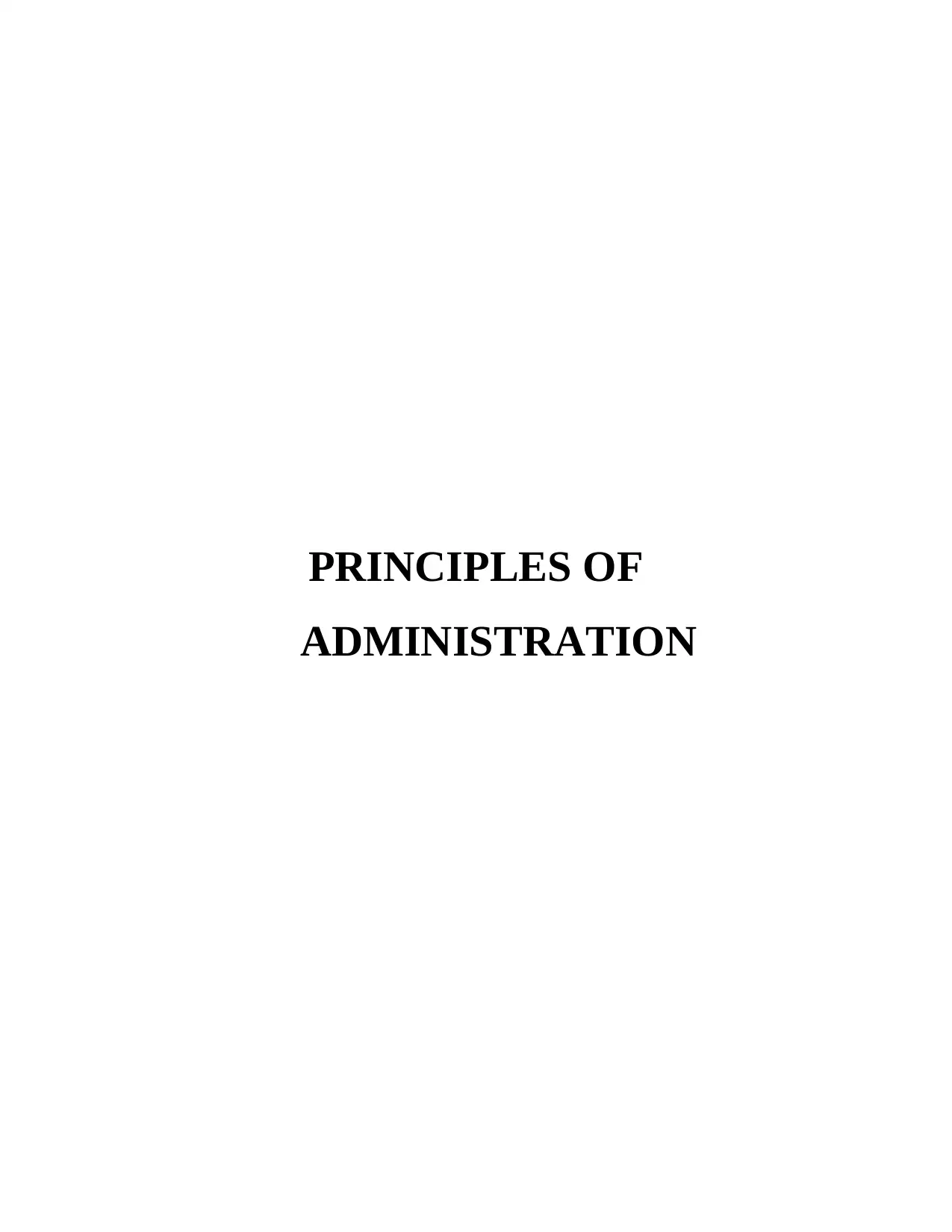
PRINCIPLES OF
ADMINISTRATION
ADMINISTRATION
Paraphrase This Document
Need a fresh take? Get an instant paraphrase of this document with our AI Paraphraser
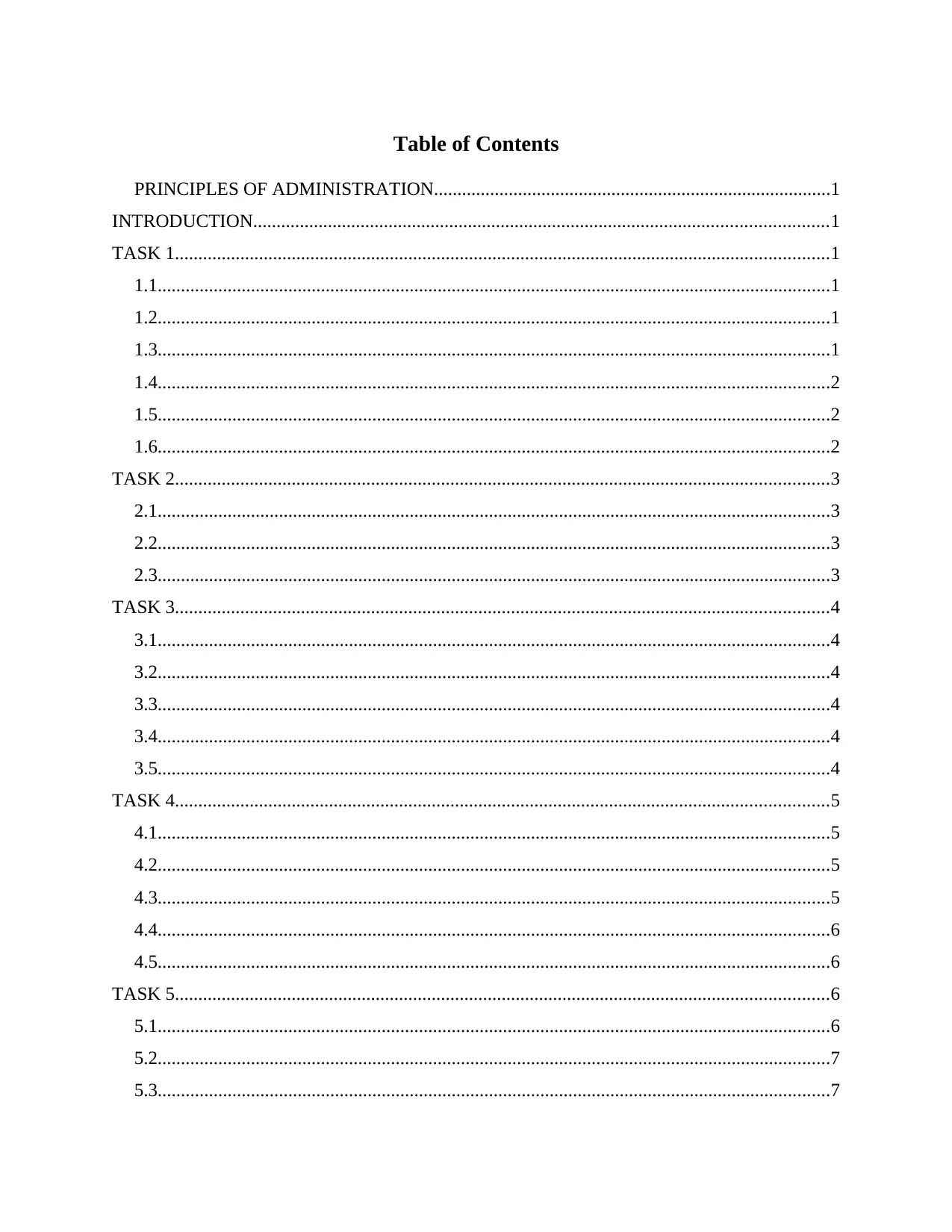
Table of Contents
PRINCIPLES OF ADMINISTRATION.....................................................................................1
INTRODUCTION...........................................................................................................................1
TASK 1............................................................................................................................................1
1.1................................................................................................................................................1
1.2................................................................................................................................................1
1.3................................................................................................................................................1
1.4................................................................................................................................................2
1.5................................................................................................................................................2
1.6................................................................................................................................................2
TASK 2............................................................................................................................................3
2.1................................................................................................................................................3
2.2................................................................................................................................................3
2.3................................................................................................................................................3
TASK 3............................................................................................................................................4
3.1................................................................................................................................................4
3.2................................................................................................................................................4
3.3................................................................................................................................................4
3.4................................................................................................................................................4
3.5................................................................................................................................................4
TASK 4............................................................................................................................................5
4.1................................................................................................................................................5
4.2................................................................................................................................................5
4.3................................................................................................................................................5
4.4................................................................................................................................................6
4.5................................................................................................................................................6
TASK 5............................................................................................................................................6
5.1................................................................................................................................................6
5.2................................................................................................................................................7
5.3................................................................................................................................................7
PRINCIPLES OF ADMINISTRATION.....................................................................................1
INTRODUCTION...........................................................................................................................1
TASK 1............................................................................................................................................1
1.1................................................................................................................................................1
1.2................................................................................................................................................1
1.3................................................................................................................................................1
1.4................................................................................................................................................2
1.5................................................................................................................................................2
1.6................................................................................................................................................2
TASK 2............................................................................................................................................3
2.1................................................................................................................................................3
2.2................................................................................................................................................3
2.3................................................................................................................................................3
TASK 3............................................................................................................................................4
3.1................................................................................................................................................4
3.2................................................................................................................................................4
3.3................................................................................................................................................4
3.4................................................................................................................................................4
3.5................................................................................................................................................4
TASK 4............................................................................................................................................5
4.1................................................................................................................................................5
4.2................................................................................................................................................5
4.3................................................................................................................................................5
4.4................................................................................................................................................6
4.5................................................................................................................................................6
TASK 5............................................................................................................................................6
5.1................................................................................................................................................6
5.2................................................................................................................................................7
5.3................................................................................................................................................7
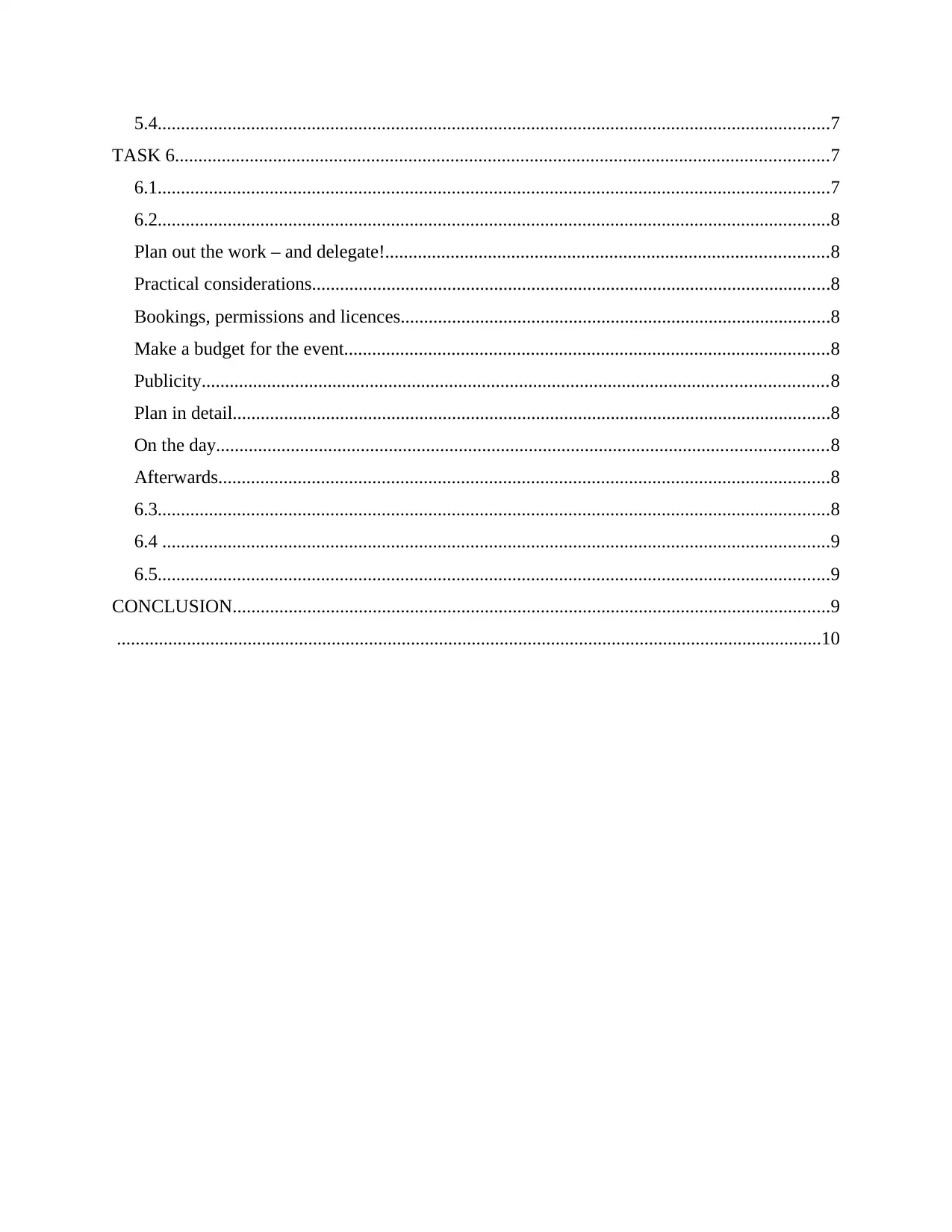
5.4................................................................................................................................................7
TASK 6............................................................................................................................................7
6.1................................................................................................................................................7
6.2................................................................................................................................................8
Plan out the work – and delegate!...............................................................................................8
Practical considerations...............................................................................................................8
Bookings, permissions and licences............................................................................................8
Make a budget for the event........................................................................................................8
Publicity......................................................................................................................................8
Plan in detail................................................................................................................................8
On the day...................................................................................................................................8
Afterwards...................................................................................................................................8
6.3................................................................................................................................................8
6.4 ...............................................................................................................................................9
6.5................................................................................................................................................9
CONCLUSION................................................................................................................................9
.......................................................................................................................................................10
TASK 6............................................................................................................................................7
6.1................................................................................................................................................7
6.2................................................................................................................................................8
Plan out the work – and delegate!...............................................................................................8
Practical considerations...............................................................................................................8
Bookings, permissions and licences............................................................................................8
Make a budget for the event........................................................................................................8
Publicity......................................................................................................................................8
Plan in detail................................................................................................................................8
On the day...................................................................................................................................8
Afterwards...................................................................................................................................8
6.3................................................................................................................................................8
6.4 ...............................................................................................................................................9
6.5................................................................................................................................................9
CONCLUSION................................................................................................................................9
.......................................................................................................................................................10
⊘ This is a preview!⊘
Do you want full access?
Subscribe today to unlock all pages.

Trusted by 1+ million students worldwide
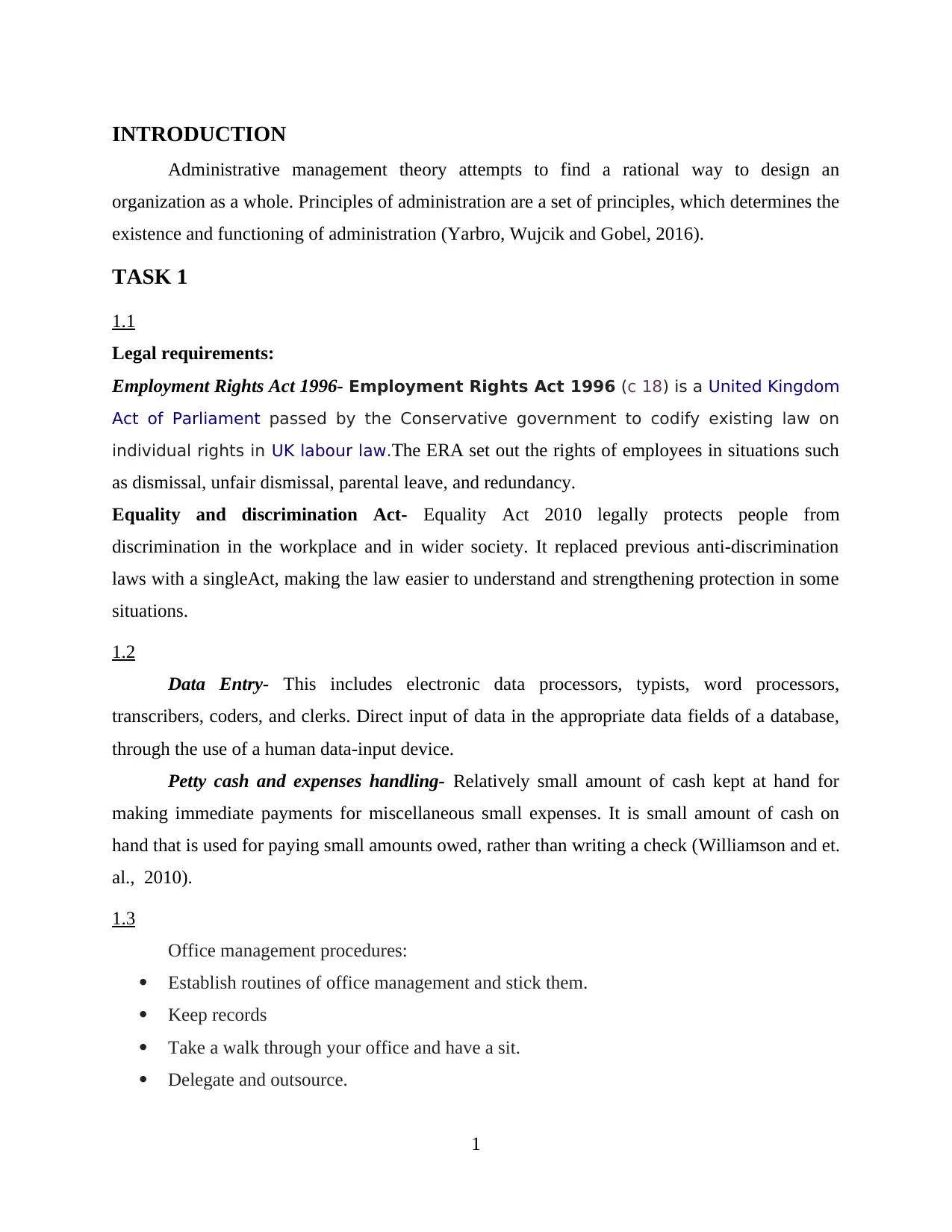
INTRODUCTION
Administrative management theory attempts to find a rational way to design an
organization as a whole. Principles of administration are a set of principles, which determines the
existence and functioning of administration (Yarbro, Wujcik and Gobel, 2016).
TASK 1
1.1
Legal requirements:
Employment Rights Act 1996- Employment Rights Act 1996 (c 18) is a United Kingdom
Act of Parliament passed by the Conservative government to codify existing law on
individual rights in UK labour law.The ERA set out the rights of employees in situations such
as dismissal, unfair dismissal, parental leave, and redundancy.
Equality and discrimination Act- Equality Act 2010 legally protects people from
discrimination in the workplace and in wider society. It replaced previous anti-discrimination
laws with a singleAct, making the law easier to understand and strengthening protection in some
situations.
1.2
Data Entry- This includes electronic data processors, typists, word processors,
transcribers, coders, and clerks. Direct input of data in the appropriate data fields of a database,
through the use of a human data-input device.
Petty cash and expenses handling- Relatively small amount of cash kept at hand for
making immediate payments for miscellaneous small expenses. It is small amount of cash on
hand that is used for paying small amounts owed, rather than writing a check (Williamson and et.
al., 2010).
1.3
Office management procedures:
Establish routines of office management and stick them.
Keep records
Take a walk through your office and have a sit.
Delegate and outsource.
1
Administrative management theory attempts to find a rational way to design an
organization as a whole. Principles of administration are a set of principles, which determines the
existence and functioning of administration (Yarbro, Wujcik and Gobel, 2016).
TASK 1
1.1
Legal requirements:
Employment Rights Act 1996- Employment Rights Act 1996 (c 18) is a United Kingdom
Act of Parliament passed by the Conservative government to codify existing law on
individual rights in UK labour law.The ERA set out the rights of employees in situations such
as dismissal, unfair dismissal, parental leave, and redundancy.
Equality and discrimination Act- Equality Act 2010 legally protects people from
discrimination in the workplace and in wider society. It replaced previous anti-discrimination
laws with a singleAct, making the law easier to understand and strengthening protection in some
situations.
1.2
Data Entry- This includes electronic data processors, typists, word processors,
transcribers, coders, and clerks. Direct input of data in the appropriate data fields of a database,
through the use of a human data-input device.
Petty cash and expenses handling- Relatively small amount of cash kept at hand for
making immediate payments for miscellaneous small expenses. It is small amount of cash on
hand that is used for paying small amounts owed, rather than writing a check (Williamson and et.
al., 2010).
1.3
Office management procedures:
Establish routines of office management and stick them.
Keep records
Take a walk through your office and have a sit.
Delegate and outsource.
1
Paraphrase This Document
Need a fresh take? Get an instant paraphrase of this document with our AI Paraphraser

Develop business planning a priority
1.4
Resource management is the efficient and effective development of an organization's
resources when they are needed (Zevenbergen and et. al., 2013). Such resources may include
financial resources, inventory, human skills, production resources, or information technology
(IT). Some points are involved:
Set maximum financial spending limits on your monthly
Keep a list of different suppliers for the same type equipment.
Base buying decisions for equipment, supplies.
Stock up on office supplies, services
Pay your suppliers on time
View your cash flow statement
Calculate your cash conversion cycle
1.5
Continually monitoring and looking for ways to improve workplace operations can help
an organization stay on financial track.
Give your employees more responsibility
Consider e-signing
Clean up your clutter
Measure productivity
Differentiate between important and urgent
Collaborate in the cloud
1.6
The Welfare Facilities and Arrangements heading covers the following:
clothing storage.
facilities for pregnant women and nursing mothers.
facilities for eating.
somewhere to rest and eat meals
a clean workplace with appropriate waste containers.
properly maintain your premises and work equipment.
2
1.4
Resource management is the efficient and effective development of an organization's
resources when they are needed (Zevenbergen and et. al., 2013). Such resources may include
financial resources, inventory, human skills, production resources, or information technology
(IT). Some points are involved:
Set maximum financial spending limits on your monthly
Keep a list of different suppliers for the same type equipment.
Base buying decisions for equipment, supplies.
Stock up on office supplies, services
Pay your suppliers on time
View your cash flow statement
Calculate your cash conversion cycle
1.5
Continually monitoring and looking for ways to improve workplace operations can help
an organization stay on financial track.
Give your employees more responsibility
Consider e-signing
Clean up your clutter
Measure productivity
Differentiate between important and urgent
Collaborate in the cloud
1.6
The Welfare Facilities and Arrangements heading covers the following:
clothing storage.
facilities for pregnant women and nursing mothers.
facilities for eating.
somewhere to rest and eat meals
a clean workplace with appropriate waste containers.
properly maintain your premises and work equipment.
2

TASK 2
2.1
Employers have legal responsibilities to ensure a safe and healthy workplace. As an
employee you have rights and you have responsibilities for your own well being and that of your
colleagues. Duties of employer includes:
a safe system of work
a safe place of work
safe equipment, plant and machinery
safe and competent people working alongside you, because employers are also liable for the
actions of their staff and managers (Taddei, Bruno and Ghiadoni, 2011).
2.2
As far as possible, to have any risks to your health and safety properly controlled
Take reasonable care within the workplace
To tell your employer about any health and safety concerns you have
Make proper use of equipment
2.3
Procedure is given below:
First aid boxes at various places
Trained first aiders – on all floors of a building
Plan what to do, including how to call the emergency services. Help them by clearly
marking your premises from the road. Consider drawing up a simple plan showing the
location of hazardous items
Decide where to go to reach a place of safety or to get rescue equipment. You must
provide suitable forms of emergency lighting
Work should not resume after an emergency if a serious danger remains. If you have any
doubts ask for assistance from the emergency services
3
2.1
Employers have legal responsibilities to ensure a safe and healthy workplace. As an
employee you have rights and you have responsibilities for your own well being and that of your
colleagues. Duties of employer includes:
a safe system of work
a safe place of work
safe equipment, plant and machinery
safe and competent people working alongside you, because employers are also liable for the
actions of their staff and managers (Taddei, Bruno and Ghiadoni, 2011).
2.2
As far as possible, to have any risks to your health and safety properly controlled
Take reasonable care within the workplace
To tell your employer about any health and safety concerns you have
Make proper use of equipment
2.3
Procedure is given below:
First aid boxes at various places
Trained first aiders – on all floors of a building
Plan what to do, including how to call the emergency services. Help them by clearly
marking your premises from the road. Consider drawing up a simple plan showing the
location of hazardous items
Decide where to go to reach a place of safety or to get rescue equipment. You must
provide suitable forms of emergency lighting
Work should not resume after an emergency if a serious danger remains. If you have any
doubts ask for assistance from the emergency services
3
⊘ This is a preview!⊘
Do you want full access?
Subscribe today to unlock all pages.

Trusted by 1+ million students worldwide
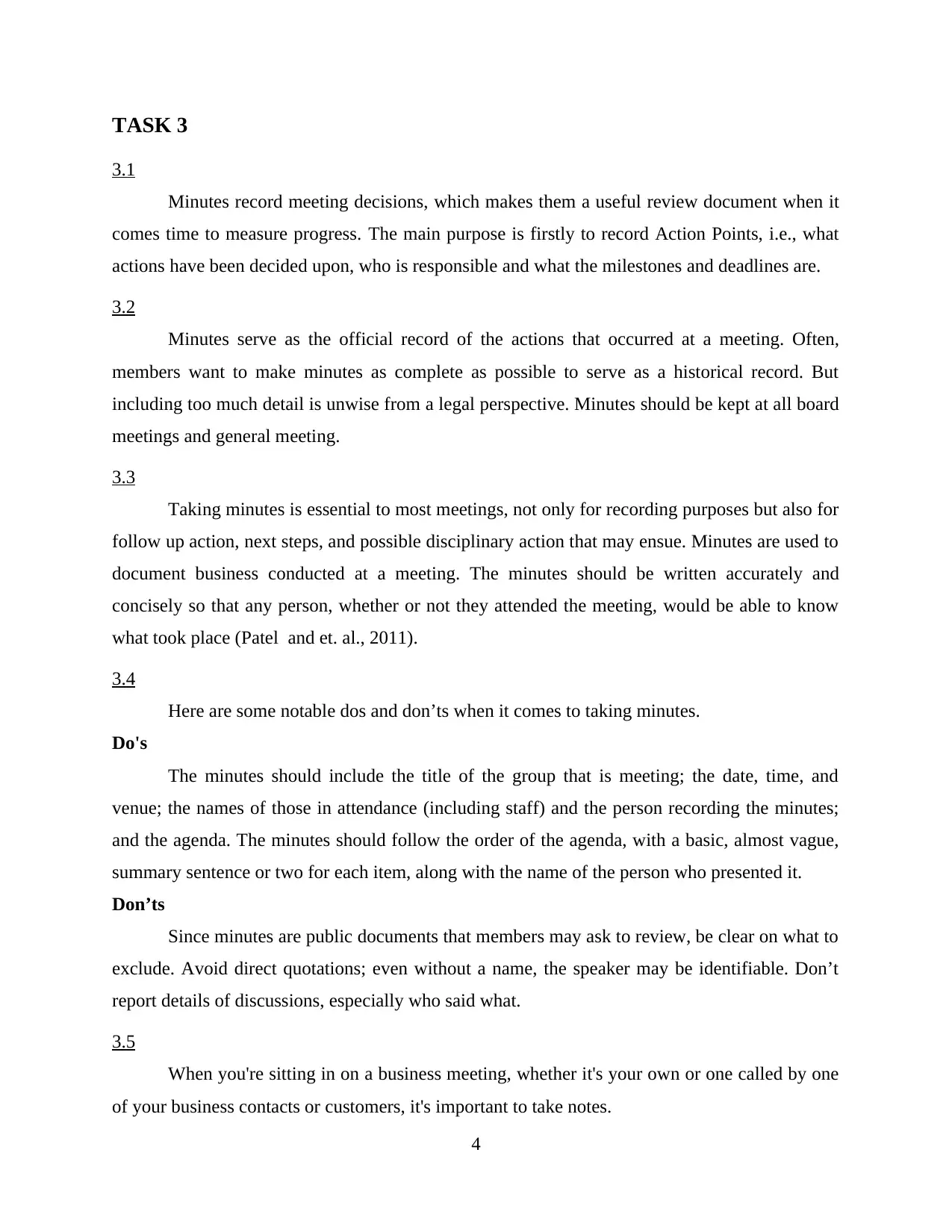
TASK 3
3.1
Minutes record meeting decisions, which makes them a useful review document when it
comes time to measure progress. The main purpose is firstly to record Action Points, i.e., what
actions have been decided upon, who is responsible and what the milestones and deadlines are.
3.2
Minutes serve as the official record of the actions that occurred at a meeting. Often,
members want to make minutes as complete as possible to serve as a historical record. But
including too much detail is unwise from a legal perspective. Minutes should be kept at all board
meetings and general meeting.
3.3
Taking minutes is essential to most meetings, not only for recording purposes but also for
follow up action, next steps, and possible disciplinary action that may ensue. Minutes are used to
document business conducted at a meeting. The minutes should be written accurately and
concisely so that any person, whether or not they attended the meeting, would be able to know
what took place (Patel and et. al., 2011).
3.4
Here are some notable dos and don’ts when it comes to taking minutes.
Do's
The minutes should include the title of the group that is meeting; the date, time, and
venue; the names of those in attendance (including staff) and the person recording the minutes;
and the agenda. The minutes should follow the order of the agenda, with a basic, almost vague,
summary sentence or two for each item, along with the name of the person who presented it.
Don’ts
Since minutes are public documents that members may ask to review, be clear on what to
exclude. Avoid direct quotations; even without a name, the speaker may be identifiable. Don’t
report details of discussions, especially who said what.
3.5
When you're sitting in on a business meeting, whether it's your own or one called by one
of your business contacts or customers, it's important to take notes.
4
3.1
Minutes record meeting decisions, which makes them a useful review document when it
comes time to measure progress. The main purpose is firstly to record Action Points, i.e., what
actions have been decided upon, who is responsible and what the milestones and deadlines are.
3.2
Minutes serve as the official record of the actions that occurred at a meeting. Often,
members want to make minutes as complete as possible to serve as a historical record. But
including too much detail is unwise from a legal perspective. Minutes should be kept at all board
meetings and general meeting.
3.3
Taking minutes is essential to most meetings, not only for recording purposes but also for
follow up action, next steps, and possible disciplinary action that may ensue. Minutes are used to
document business conducted at a meeting. The minutes should be written accurately and
concisely so that any person, whether or not they attended the meeting, would be able to know
what took place (Patel and et. al., 2011).
3.4
Here are some notable dos and don’ts when it comes to taking minutes.
Do's
The minutes should include the title of the group that is meeting; the date, time, and
venue; the names of those in attendance (including staff) and the person recording the minutes;
and the agenda. The minutes should follow the order of the agenda, with a basic, almost vague,
summary sentence or two for each item, along with the name of the person who presented it.
Don’ts
Since minutes are public documents that members may ask to review, be clear on what to
exclude. Avoid direct quotations; even without a name, the speaker may be identifiable. Don’t
report details of discussions, especially who said what.
3.5
When you're sitting in on a business meeting, whether it's your own or one called by one
of your business contacts or customers, it's important to take notes.
4
Paraphrase This Document
Need a fresh take? Get an instant paraphrase of this document with our AI Paraphraser

1. Use pen and paper. Using pen and paper is less intrusive and easier to use. ...
2. Learn shorthand. ...
3. Just highlight the key points. ...
Prepare a written report immediately after the meeting.
TASK 4
4.1
Formal meetings
A formal meeting is a pre-planned gathering of two or more people who have assembled
for the purpose of achieving a common goal through verbal interaction.
Purpose
Purpose of a formal meeting is to discuss the list of predetermined topics and address the
set of objectives, and make decisions relating to them (Hughes, 2012).
Informal meetings
It is a meeting which is far less heavily planned and regulated than a formal business
meeting, and so lacks many of the defining features of a formal business meeting, such as
minutes, a chairperson and a set agenda.
Purpose
Its purpose is to discuss issues which would not have an appropriate place in a formal
meeting.
4.2
The principal role of the Chairman of the Board is to manage and to provide leadership to
the Board of Directors of the Company. The Chairman is accountable to the Board and acts as a
direct liaison between the Board and the management of the Company, through the Chief
Executive Officer (“CEO”).
4.3
Participants were chosen because of their knowledge, skills, and responsibilities.
Meeting Members- These individuals are the active participants during a meeting. They
are the ones called for to attend a meeting.
Minute Taker- The minute taker is otherwise known as the note-taker or recorder. This
person takes a neutral stance just like the facilitator.
5
2. Learn shorthand. ...
3. Just highlight the key points. ...
Prepare a written report immediately after the meeting.
TASK 4
4.1
Formal meetings
A formal meeting is a pre-planned gathering of two or more people who have assembled
for the purpose of achieving a common goal through verbal interaction.
Purpose
Purpose of a formal meeting is to discuss the list of predetermined topics and address the
set of objectives, and make decisions relating to them (Hughes, 2012).
Informal meetings
It is a meeting which is far less heavily planned and regulated than a formal business
meeting, and so lacks many of the defining features of a formal business meeting, such as
minutes, a chairperson and a set agenda.
Purpose
Its purpose is to discuss issues which would not have an appropriate place in a formal
meeting.
4.2
The principal role of the Chairman of the Board is to manage and to provide leadership to
the Board of Directors of the Company. The Chairman is accountable to the Board and acts as a
direct liaison between the Board and the management of the Company, through the Chief
Executive Officer (“CEO”).
4.3
Participants were chosen because of their knowledge, skills, and responsibilities.
Meeting Members- These individuals are the active participants during a meeting. They
are the ones called for to attend a meeting.
Minute Taker- The minute taker is otherwise known as the note-taker or recorder. This
person takes a neutral stance just like the facilitator.
5
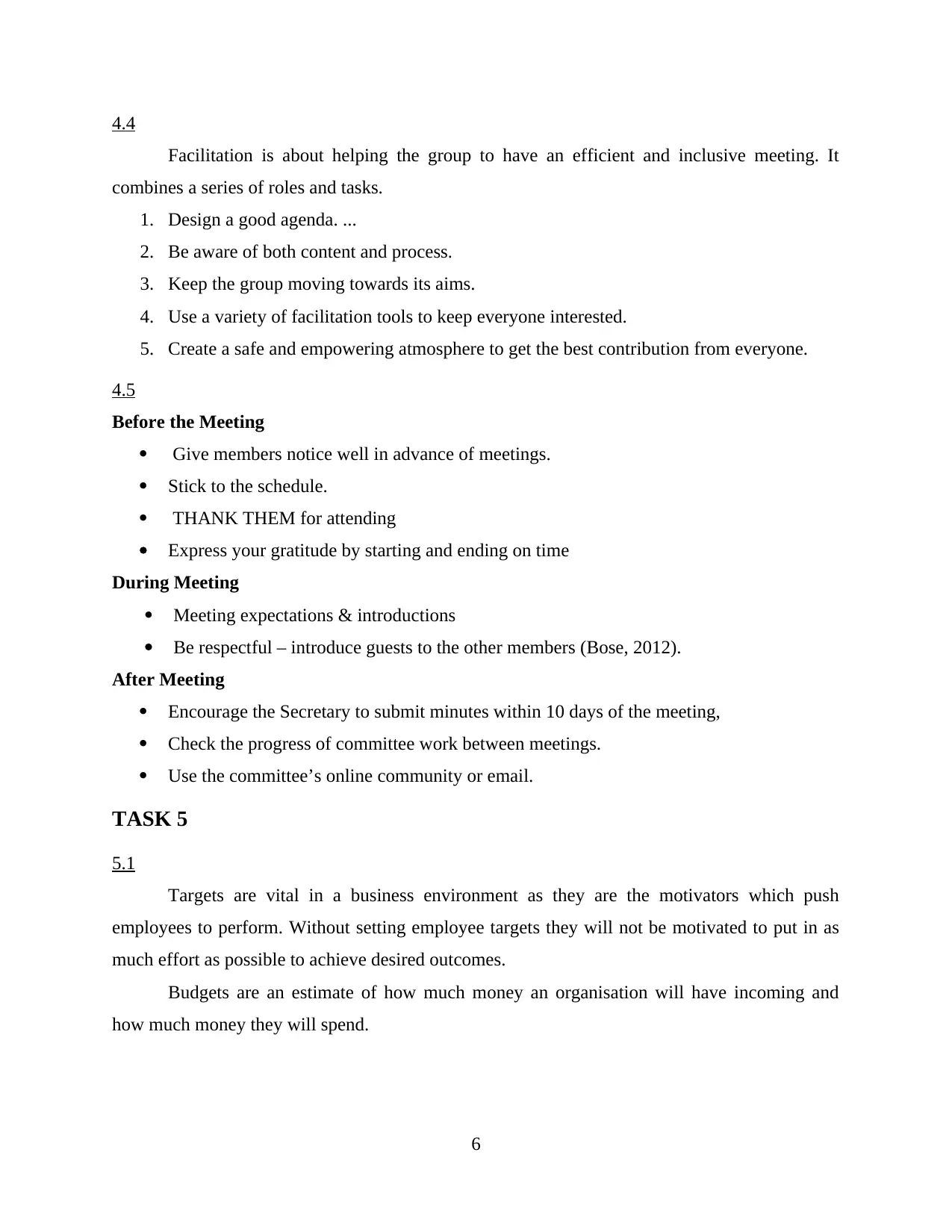
4.4
Facilitation is about helping the group to have an efficient and inclusive meeting. It
combines a series of roles and tasks.
1. Design a good agenda. ...
2. Be aware of both content and process.
3. Keep the group moving towards its aims.
4. Use a variety of facilitation tools to keep everyone interested.
5. Create a safe and empowering atmosphere to get the best contribution from everyone.
4.5
Before the Meeting
Give members notice well in advance of meetings.
Stick to the schedule.
THANK THEM for attending
Express your gratitude by starting and ending on time
During Meeting
Meeting expectations & introductions
Be respectful – introduce guests to the other members (Bose, 2012).
After Meeting
Encourage the Secretary to submit minutes within 10 days of the meeting,
Check the progress of committee work between meetings.
Use the committee’s online community or email.
TASK 5
5.1
Targets are vital in a business environment as they are the motivators which push
employees to perform. Without setting employee targets they will not be motivated to put in as
much effort as possible to achieve desired outcomes.
Budgets are an estimate of how much money an organisation will have incoming and
how much money they will spend.
6
Facilitation is about helping the group to have an efficient and inclusive meeting. It
combines a series of roles and tasks.
1. Design a good agenda. ...
2. Be aware of both content and process.
3. Keep the group moving towards its aims.
4. Use a variety of facilitation tools to keep everyone interested.
5. Create a safe and empowering atmosphere to get the best contribution from everyone.
4.5
Before the Meeting
Give members notice well in advance of meetings.
Stick to the schedule.
THANK THEM for attending
Express your gratitude by starting and ending on time
During Meeting
Meeting expectations & introductions
Be respectful – introduce guests to the other members (Bose, 2012).
After Meeting
Encourage the Secretary to submit minutes within 10 days of the meeting,
Check the progress of committee work between meetings.
Use the committee’s online community or email.
TASK 5
5.1
Targets are vital in a business environment as they are the motivators which push
employees to perform. Without setting employee targets they will not be motivated to put in as
much effort as possible to achieve desired outcomes.
Budgets are an estimate of how much money an organisation will have incoming and
how much money they will spend.
6
⊘ This is a preview!⊘
Do you want full access?
Subscribe today to unlock all pages.

Trusted by 1+ million students worldwide
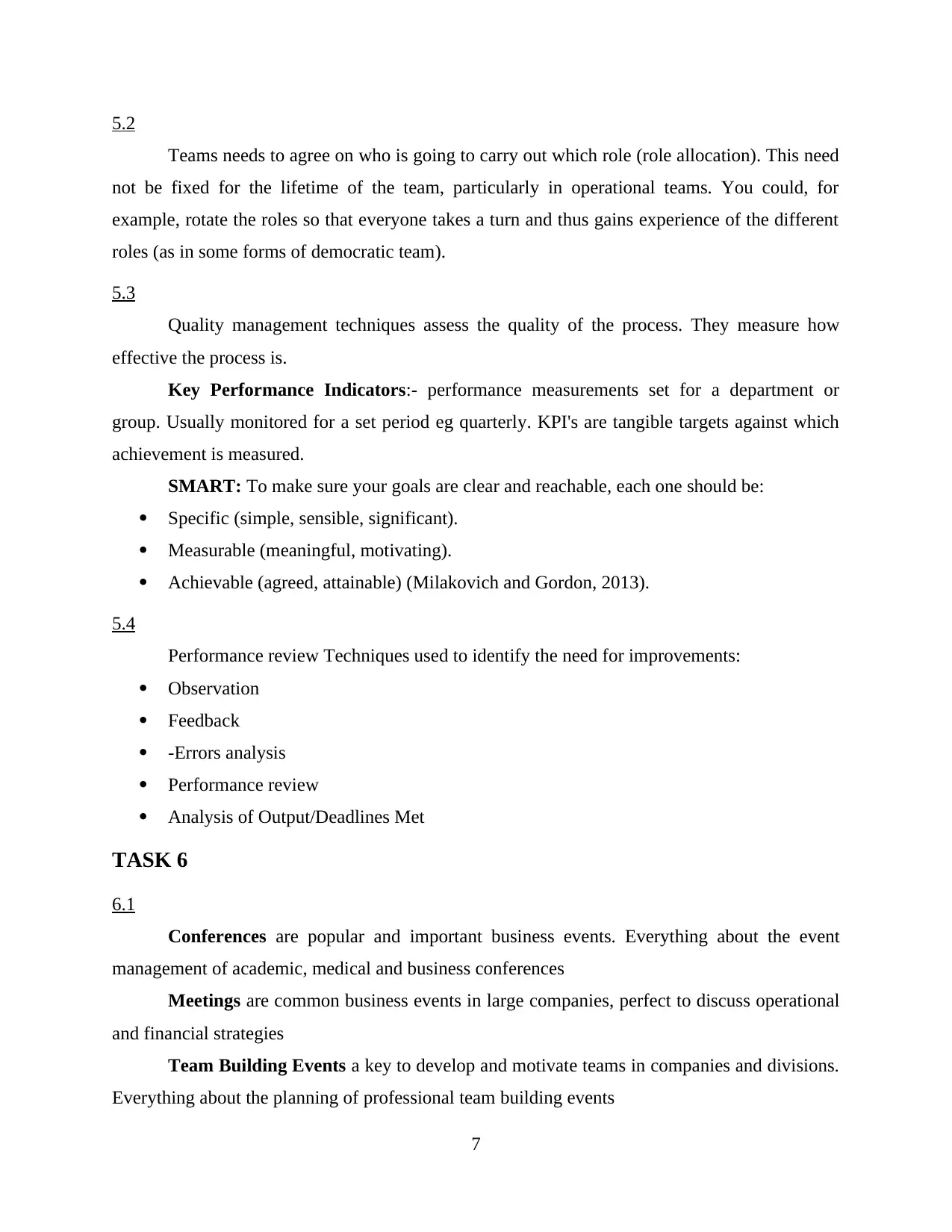
5.2
Teams needs to agree on who is going to carry out which role (role allocation). This need
not be fixed for the lifetime of the team, particularly in operational teams. You could, for
example, rotate the roles so that everyone takes a turn and thus gains experience of the different
roles (as in some forms of democratic team).
5.3
Quality management techniques assess the quality of the process. They measure how
effective the process is.
Key Performance Indicators:- performance measurements set for a department or
group. Usually monitored for a set period eg quarterly. KPI's are tangible targets against which
achievement is measured.
SMART: To make sure your goals are clear and reachable, each one should be:
Specific (simple, sensible, significant).
Measurable (meaningful, motivating).
Achievable (agreed, attainable) (Milakovich and Gordon, 2013).
5.4
Performance review Techniques used to identify the need for improvements:
Observation
Feedback
-Errors analysis
Performance review
Analysis of Output/Deadlines Met
TASK 6
6.1
Conferences are popular and important business events. Everything about the event
management of academic, medical and business conferences
Meetings are common business events in large companies, perfect to discuss operational
and financial strategies
Team Building Events a key to develop and motivate teams in companies and divisions.
Everything about the planning of professional team building events
7
Teams needs to agree on who is going to carry out which role (role allocation). This need
not be fixed for the lifetime of the team, particularly in operational teams. You could, for
example, rotate the roles so that everyone takes a turn and thus gains experience of the different
roles (as in some forms of democratic team).
5.3
Quality management techniques assess the quality of the process. They measure how
effective the process is.
Key Performance Indicators:- performance measurements set for a department or
group. Usually monitored for a set period eg quarterly. KPI's are tangible targets against which
achievement is measured.
SMART: To make sure your goals are clear and reachable, each one should be:
Specific (simple, sensible, significant).
Measurable (meaningful, motivating).
Achievable (agreed, attainable) (Milakovich and Gordon, 2013).
5.4
Performance review Techniques used to identify the need for improvements:
Observation
Feedback
-Errors analysis
Performance review
Analysis of Output/Deadlines Met
TASK 6
6.1
Conferences are popular and important business events. Everything about the event
management of academic, medical and business conferences
Meetings are common business events in large companies, perfect to discuss operational
and financial strategies
Team Building Events a key to develop and motivate teams in companies and divisions.
Everything about the planning of professional team building events
7
Paraphrase This Document
Need a fresh take? Get an instant paraphrase of this document with our AI Paraphraser
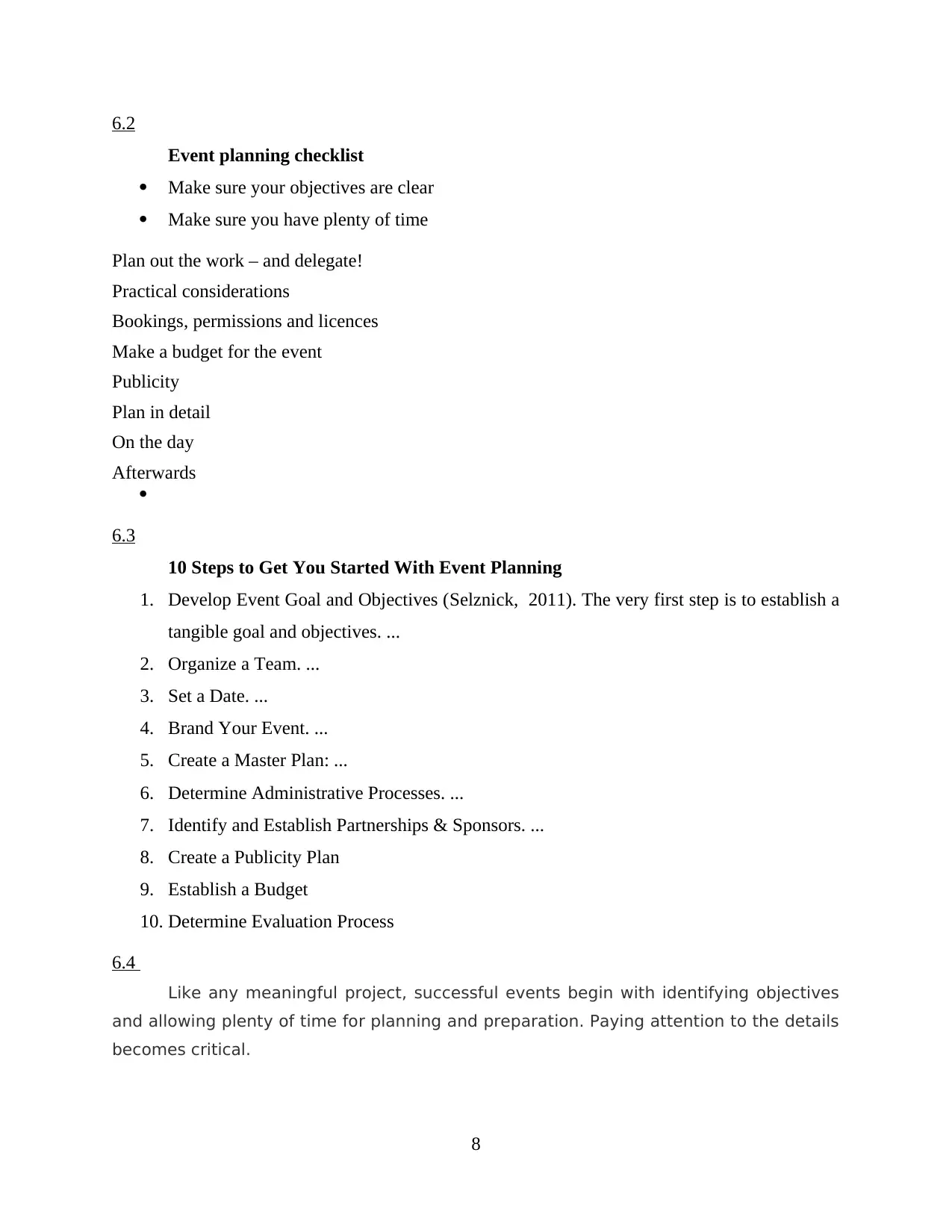
6.2
Event planning checklist
Make sure your objectives are clear
Make sure you have plenty of time
Plan out the work – and delegate!
Practical considerations
Bookings, permissions and licences
Make a budget for the event
Publicity
Plan in detail
On the day
Afterwards
6.3
10 Steps to Get You Started With Event Planning
1. Develop Event Goal and Objectives (Selznick, 2011). The very first step is to establish a
tangible goal and objectives. ...
2. Organize a Team. ...
3. Set a Date. ...
4. Brand Your Event. ...
5. Create a Master Plan: ...
6. Determine Administrative Processes. ...
7. Identify and Establish Partnerships & Sponsors. ...
8. Create a Publicity Plan
9. Establish a Budget
10. Determine Evaluation Process
6.4
Like any meaningful project, successful events begin with identifying objectives
and allowing plenty of time for planning and preparation. Paying attention to the details
becomes critical.
8
Event planning checklist
Make sure your objectives are clear
Make sure you have plenty of time
Plan out the work – and delegate!
Practical considerations
Bookings, permissions and licences
Make a budget for the event
Publicity
Plan in detail
On the day
Afterwards
6.3
10 Steps to Get You Started With Event Planning
1. Develop Event Goal and Objectives (Selznick, 2011). The very first step is to establish a
tangible goal and objectives. ...
2. Organize a Team. ...
3. Set a Date. ...
4. Brand Your Event. ...
5. Create a Master Plan: ...
6. Determine Administrative Processes. ...
7. Identify and Establish Partnerships & Sponsors. ...
8. Create a Publicity Plan
9. Establish a Budget
10. Determine Evaluation Process
6.4
Like any meaningful project, successful events begin with identifying objectives
and allowing plenty of time for planning and preparation. Paying attention to the details
becomes critical.
8
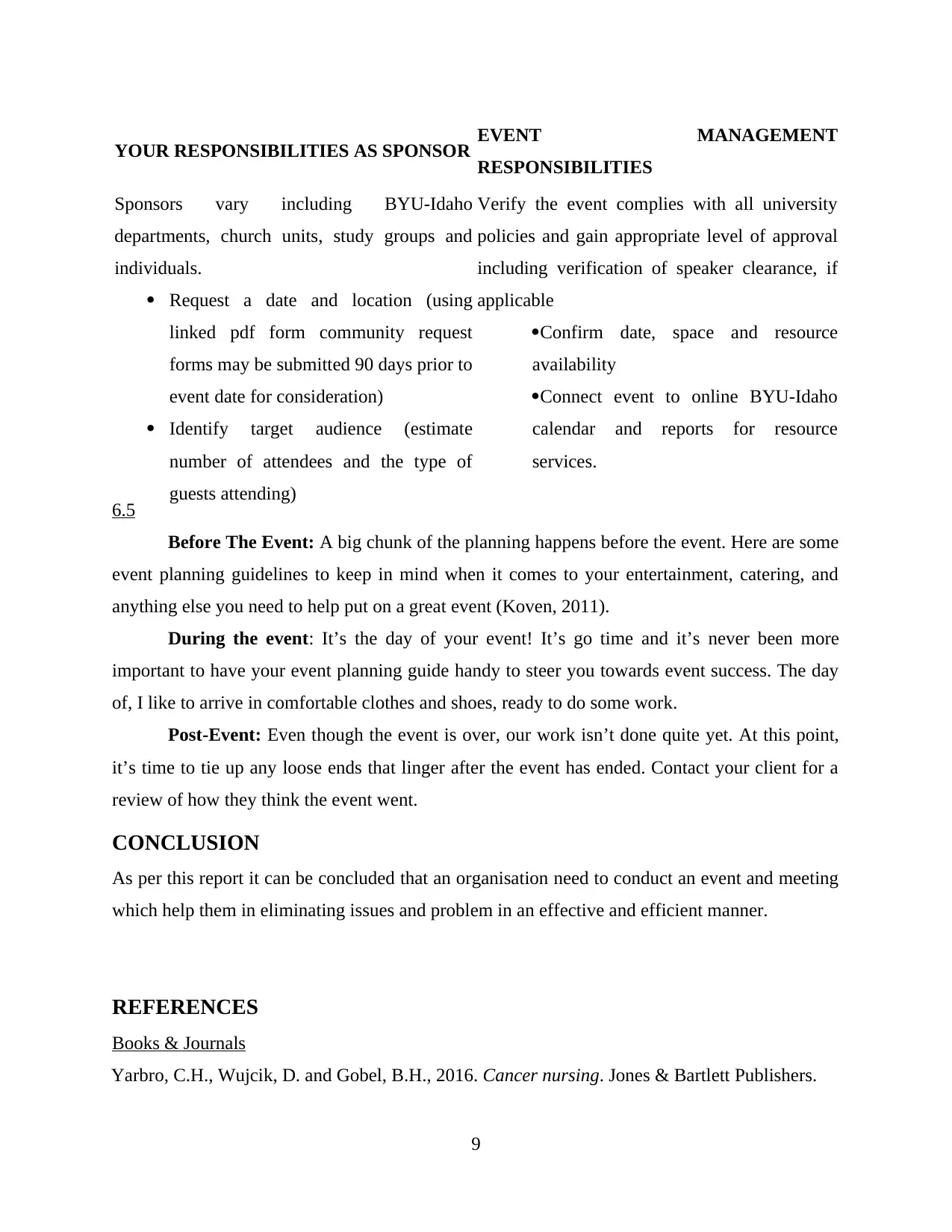
6.5
Before The Event: A big chunk of the planning happens before the event. Here are some
event planning guidelines to keep in mind when it comes to your entertainment, catering, and
anything else you need to help put on a great event (Koven, 2011).
During the event: It’s the day of your event! It’s go time and it’s never been more
important to have your event planning guide handy to steer you towards event success. The day
of, I like to arrive in comfortable clothes and shoes, ready to do some work.
Post-Event: Even though the event is over, our work isn’t done quite yet. At this point,
it’s time to tie up any loose ends that linger after the event has ended. Contact your client for a
review of how they think the event went.
CONCLUSION
As per this report it can be concluded that an organisation need to conduct an event and meeting
which help them in eliminating issues and problem in an effective and efficient manner.
REFERENCES
Books & Journals
Yarbro, C.H., Wujcik, D. and Gobel, B.H., 2016. Cancer nursing. Jones & Bartlett Publishers.
9
YOUR RESPONSIBILITIES AS SPONSOR EVENT MANAGEMENT
RESPONSIBILITIES
Sponsors vary including BYU-Idaho
departments, church units, study groups and
individuals.
Request a date and location (using
linked pdf form community request
forms may be submitted 90 days prior to
event date for consideration)
Identify target audience (estimate
number of attendees and the type of
guests attending)
Verify the event complies with all university
policies and gain appropriate level of approval
including verification of speaker clearance, if
applicable
Confirm date, space and resource
availability
Connect event to online BYU-Idaho
calendar and reports for resource
services.
Before The Event: A big chunk of the planning happens before the event. Here are some
event planning guidelines to keep in mind when it comes to your entertainment, catering, and
anything else you need to help put on a great event (Koven, 2011).
During the event: It’s the day of your event! It’s go time and it’s never been more
important to have your event planning guide handy to steer you towards event success. The day
of, I like to arrive in comfortable clothes and shoes, ready to do some work.
Post-Event: Even though the event is over, our work isn’t done quite yet. At this point,
it’s time to tie up any loose ends that linger after the event has ended. Contact your client for a
review of how they think the event went.
CONCLUSION
As per this report it can be concluded that an organisation need to conduct an event and meeting
which help them in eliminating issues and problem in an effective and efficient manner.
REFERENCES
Books & Journals
Yarbro, C.H., Wujcik, D. and Gobel, B.H., 2016. Cancer nursing. Jones & Bartlett Publishers.
9
YOUR RESPONSIBILITIES AS SPONSOR EVENT MANAGEMENT
RESPONSIBILITIES
Sponsors vary including BYU-Idaho
departments, church units, study groups and
individuals.
Request a date and location (using
linked pdf form community request
forms may be submitted 90 days prior to
event date for consideration)
Identify target audience (estimate
number of attendees and the type of
guests attending)
Verify the event complies with all university
policies and gain appropriate level of approval
including verification of speaker clearance, if
applicable
Confirm date, space and resource
availability
Connect event to online BYU-Idaho
calendar and reports for resource
services.
⊘ This is a preview!⊘
Do you want full access?
Subscribe today to unlock all pages.

Trusted by 1+ million students worldwide
1 out of 14
Related Documents
Your All-in-One AI-Powered Toolkit for Academic Success.
+13062052269
info@desklib.com
Available 24*7 on WhatsApp / Email
![[object Object]](/_next/static/media/star-bottom.7253800d.svg)
Unlock your academic potential
Copyright © 2020–2025 A2Z Services. All Rights Reserved. Developed and managed by ZUCOL.





